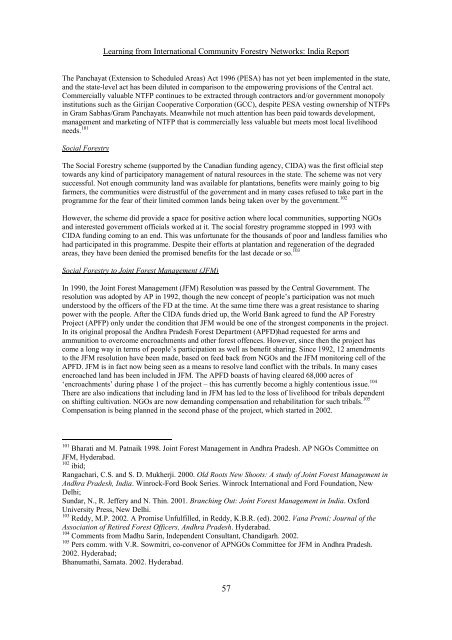Snapshots of International Community Forestry Networks: Country ...
Snapshots of International Community Forestry Networks: Country ...
Snapshots of International Community Forestry Networks: Country ...
You also want an ePaper? Increase the reach of your titles
YUMPU automatically turns print PDFs into web optimized ePapers that Google loves.
Learning from <strong>International</strong> <strong>Community</strong> <strong>Forestry</strong> <strong>Networks</strong>: India Report<br />
The Panchayat (Extension to Scheduled Areas) Act 1996 (PESA) has not yet been implemented in the state,<br />
and the state-level act has been diluted in comparison to the empowering provisions <strong>of</strong> the Central act.<br />
Commercially valuable NTFP continues to be extracted through contractors and/or government monopoly<br />
institutions such as the Girijan Cooperative Corporation (GCC), despite PESA vesting ownership <strong>of</strong> NTFPs<br />
in Gram Sabhas/Gram Panchayats. Meanwhile not much attention has been paid towards development,<br />
management and marketing <strong>of</strong> NTFP that is commercially less valuable but meets most local livelihood<br />
needs. 101<br />
Social <strong>Forestry</strong><br />
The Social <strong>Forestry</strong> scheme (supported by the Canadian funding agency, CIDA) was the first <strong>of</strong>ficial step<br />
towards any kind <strong>of</strong> participatory management <strong>of</strong> natural resources in the state. The scheme was not very<br />
successful. Not enough community land was available for plantations, benefits were mainly going to big<br />
farmers, the communities were distrustful <strong>of</strong> the government and in many cases refused to take part in the<br />
programme for the fear <strong>of</strong> their limited common lands being taken over by the government. 102<br />
However, the scheme did provide a space for positive action where local communities, supporting NGOs<br />
and interested government <strong>of</strong>ficials worked at it. The social forestry programme stopped in 1993 with<br />
CIDA funding coming to an end. This was unfortunate for the thousands <strong>of</strong> poor and landless families who<br />
had participated in this programme. Despite their efforts at plantation and regeneration <strong>of</strong> the degraded<br />
areas, they have been denied the promised benefits for the last decade or so. 103<br />
Social <strong>Forestry</strong> to Joint Forest Management (JFM)<br />
In 1990, the Joint Forest Management (JFM) Resolution was passed by the Central Government. The<br />
resolution was adopted by AP in 1992, though the new concept <strong>of</strong> people’s participation was not much<br />
understood by the <strong>of</strong>ficers <strong>of</strong> the FD at the time. At the same time there was a great resistance to sharing<br />
power with the people. After the CIDA funds dried up, the World Bank agreed to fund the AP <strong>Forestry</strong><br />
Project (APFP) only under the condition that JFM would be one <strong>of</strong> the strongest components in the project.<br />
In its original proposal the Andhra Pradesh Forest Department (APFD)had requested for arms and<br />
ammunition to overcome encroachments and other forest <strong>of</strong>fences. However, since then the project has<br />
come a long way in terms <strong>of</strong> people’s participation as well as benefit sharing. Since 1992, 12 amendments<br />
to the JFM resolution have been made, based on feed back from NGOs and the JFM monitoring cell <strong>of</strong> the<br />
APFD. JFM is in fact now being seen as a means to resolve land conflict with the tribals. In many cases<br />
encroached land has been included in JFM. The APFD boasts <strong>of</strong> having cleared 68,000 acres <strong>of</strong><br />
‘encroachments’ during phase 1 <strong>of</strong> the project – this has currently become a highly contentious issue. 104<br />
There are also indications that including land in JFM has led to the loss <strong>of</strong> livelihood for tribals dependent<br />
on shifting cultivation. NGOs are now demanding compensation and rehabilitation for such tribals. 105<br />
Compensation is being planned in the second phase <strong>of</strong> the project, which started in 2002.<br />
101<br />
Bharati and M. Patnaik 1998. Joint Forest Management in Andhra Pradesh. AP NGOs Committee on<br />
JFM, Hyderabad.<br />
102<br />
ibid;<br />
Rangachari, C.S. and S. D. Mukherji. 2000. Old Roots New Shoots: A study <strong>of</strong> Joint Forest Management in<br />
Andhra Pradesh, India. Winrock-Ford Book Series. Winrock <strong>International</strong> and Ford Foundation, New<br />
Delhi;<br />
Sundar, N., R. Jeffery and N. Thin. 2001. Branching Out: Joint Forest Management in India. Oxford<br />
University Press, New Delhi.<br />
103<br />
Reddy, M.P. 2002. A Promise Unfulfilled, in Reddy, K.B.R. (ed). 2002. Vana Premi: Journal <strong>of</strong> the<br />
Association <strong>of</strong> Retired Forest Officers, Andhra Pradesh. Hyderabad.<br />
104<br />
Comments from Madhu Sarin, Independent Consultant, Chandigarh. 2002.<br />
105<br />
Pers comm. with V.R. Sowmitri, co-convenor <strong>of</strong> APNGOs Committee for JFM in Andhra Pradesh.<br />
2002. Hyderabad;<br />
Bhanumathi, Samata. 2002. Hyderabad.<br />
57

















![CynefinFramework final [Read-Only]](https://img.yumpu.com/19017304/1/190x135/cynefinframework-final-read-only.jpg?quality=85)